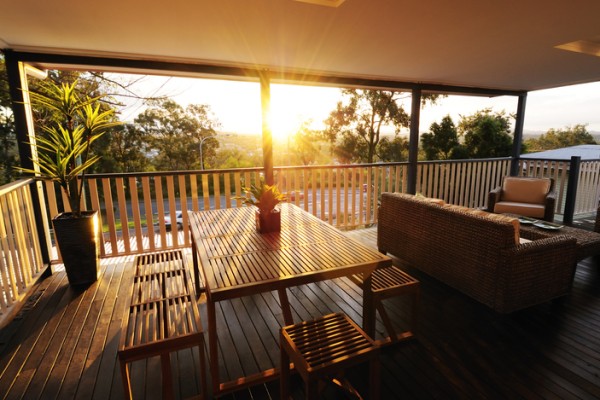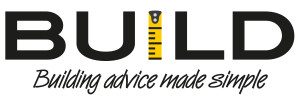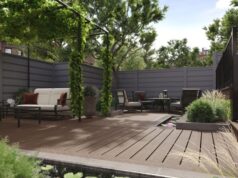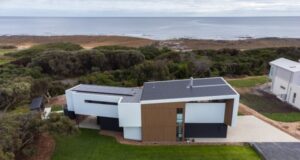
Decks are a natural extension of Australian living, giving us space to entertain, relax and blur the line between indoor and outdoor. But in bushfire-prone areas, they also represent one of the more vulnerable parts of the home.
With increasing bushfire risk and tighter regulations (especially under AS 3959:2018 and the NCC), building a compliant deck isn’t just about ticking boxes, it’s about choosing the right materials, design and installation techniques to reduce risk.
Here’s a guide to what’s changed (or needs to be understood), what materials to use, how to build for compliance, and how to maintain your deck so it remains safe as well as beautiful.
What are the rules you need to know
- AS 3959:2018 Construction of buildings in bushfire-prone areas is the Australian standard that sets out the requirements depending on the site’s Bushfire Attack Level (BAL).
- The National Construction Code (NCC) refers to this standard and requires decks (and other structures) to comply if they are on land declared “bushfire-prone”.
- BAL ratings range from BAL-LOW / BAL-12.5 (lower risk) up to BAL-FZ (Flame Zone), with increasing requirements for radiant heat, ember attack, windborne debris, and in extreme zones, direct flame contact.
In practical terms, this means that depending on your BAL, there are restrictions or requirements on:
- What materials your deck boards, joists, supports, etc. are made of (non-combustible/fire-resistant timber/etc.).
- How close decks are to windows/glazed elements and walls, as some elements require different materials or screening.
- The design of the deck: Spacing, elevation, the type of sub-frame/supports, and whether components like stair treads, landings, ramps and balustrades follow the fire-resistance rules.
What materials & design techniques meet the rules
To ensure compliance under different BALs, here are what the materials and construction practices generally look like:
| Component | Acceptable materials under stricter BALs (e.g. BAL-29, BAL-40, maybe BAL-FZ) | Notes / Common trade-offs |
| Deck boards/stair treads/ramps | Non-combustible materials; fire-resistant hardwood timbers; composite decking certified for relevant BALs. | Fire-rated composite tends to cost more; hardwood may require treatment and more maintenance. |
| Supports/framing/bearers/joists | Non-combustible (steel etc.) or bushfire-resistant timber species; in higher BALs, non-combustible is often required. | Steel framing resists fire well but must be properly fixed, and connectors/protective finishes considered to resist corrosion. |
| Balustrades, rails, stairs, landings | When close to glass or combustible wall elements, these may need non-combustible or bushfire-resistant materials, or special screening. | These detailing elements are often overlooked; avoiding combustible gaps and ensuring proper fixings helps reduce ember entry. |
| Clearances & spacing | Deck boards may need to be more tightly spaced; subfloor clearances matter (airflow helps reduce ember build-up and radiant heat transfer) etc. | Sometimes design changes are needed (e.g. raising the deck or specifying different fixings). |
Composite decking with BAL certification is increasingly popular. For instance, some composite boards are explicitly BAL-29 certified, offering better fire resistance than untreated timber options.
Installation tips & common pitfalls
When installing a deck under bushfire regulations, these are the practical “watch-outs” and tricks to get it right:
- Obtain a BAL rating early. Before you pick materials or build, have a bushfire assessment done so you know exactly which BAL applies. Without this, you can’t reliably choose materials or designs that comply.
- Check local council requirements. State and local variations matter. Even though AS 3959 is national, councils may require additional conditions or documentation.
- Use the right fixings and detailing. Fire resistance isn’t just the material, how it’s fixed, where gaps are, how joints are sealed all matter. Embers entering through gaps under the deck, between boards or at junctions to the house are frequent failure points.
- Protect glazed openings. If your deck is close (in plan) to windows or doors, those glazed elements may need screening or non-combustible materials near them. Balustrades, especially if near glass can transfer heat unless the materials used are compliant.
- Mind the sub-floor area. If the deck’s supports or framing are close to or over ground or vegetation, risk of embers collecting underneath increases. Ensuring airflow, minimal combustible material underneath, or using ember guards/screens can help.
- Inspect and maintain fixings and protective coatings. In many fire risk zones, coatings, preservative treatments or fire retardants may degrade over time, check for loosening fasteners, rust on metal parts, decay or warping in timber.
Maintaining your deck once it’s built
Even the most compliant deck won’t do much good in a bushfire unless it’s maintained. Here are the steps home owners should take over their life:
- Regular cleaning: Clear leaves, debris, bark, dried vegetation from between boards and under the deck. Embers make fuel; keeping things clean reduces ignition risk.
- Monitoring material condition: Look for signs of timber rot, splitting, warping, or corrosion in metal components. Replace or repair these before they become weak points.
- Re-coating & treating: If you used fire-resistant timber, the protective treatments might degrade; re-treat as needed. Fire retardant finishes or protective coatings can deteriorate under sun, rain or regular foot traffic.
- Maintain screening and sealing at junctions: Any screens or mesh (especially around balustrades, glazing, under the deck) should remain intact, without holes or corrosion. Silicone seals or other junctions to the house should be well-maintained to block ember ingress.
- Vegetation management: Clear zones around and under the deck must be kept. Overhanging branches, mulch or foliage close to edge zones are ember hazards.
- Insurance & documentation: Keep documentation of your BAL rating, compliance materials, treatments, and maintenance; it may help with insurance claims if damage arises, or when selling.
What’s new/changing
Some of the tighter requirements have only more recently become enforced or clarified, particularly:
- The definitions around non-combustible vs bushfire resisting timber and what qualifies under different BALs.
- Requirements related to decks, stairs, ramps and balustrades in proximity to glazing or combustible wall elements; some rules trigger stricter materials depending on distances.
- More visibility around BAL-FZ (Flame Zone) and BAL-40 requirements: In these highest risk settings, the margin for using combustible materials becomes very small; non-combustible materials, steel framing and certified composites are much more likely to be necessary.
Final word
A deck in a bushfire-prone area doesn’t have to be a fire risk, but it will take more care in design, materials, installation and ongoing maintenance than a standard backyard deck. For builders and renovators, it means being proactive: Get your BAL rating, plan for non-combustible or fire-resistant materials, seal and screen well, and don’t underestimate the importance of debris management and upkeep.
Do it right, and your deck won’t just be an outdoor living space, it’ll be one you can use with confidence in bushfire season.





